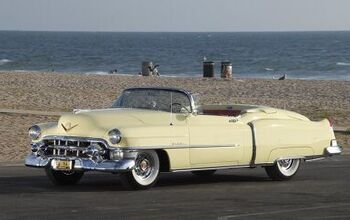Reportedly Terrible: AAA Tests Pedestrian Detection Systems

The paranoid luddites that write for this site have occasionally been accused of being hyper critical of modern-day driving aids. Be it a cursory mention of how a little snow totally flummoxed the systems of an otherwise agreeable review car, the direct addressing of an issue where road salt encouraged a vehicle to attempt to steer itself into a ditch, or one of this author’s many diatribes on how the bulk of this technology doesn’t seem anywhere near market ready, there’s always a couple of exceptional individuals ready to call us backward-looking morons.
While that’s often a correct assessment in other matters, it seems we’ve called this one correctly. The American Automobile Association (AAA) recently tested four sedans from competing manufacturers, running them through a handful of scenarios intended to replicate situations that place pedestrians at extreme risk. Taking into account the above smugness, you can probably imagine how poorly it went.
In the study, AAA used a Chevrolet Malibu (Front Pedestrian Braking), Honda Accord (Honda Sensing), Toyota Camry (Toyota Safety Sense), and Tesla Model 3 (Automatic Emergency Braking) from the 2019 model year. The testing, done in conjunction with the Automobile Club of Southern California’s Automotive Research Center, was aimed at assessing the effectiveness of the automatic emergency braking (with pedestrian detection) systems these vehicles came equipped with. Testing occurred under near-perfect conditions.
Test events included an adult crossing in front of a vehicle traveling 20 mph and 30 mph during the day and 25 mph at night, a child darting out from between two parked cars in front of a car (20 and 30 mph), a vehicle turning right onto an adjacent road with an adult crossing into traffic, and two adults standing near the side of the road with their backs to oncoming traffic (20 and 30 mph). Keen to avoid any real-world fatalities, AAA used mobile dummies as human analogs. This turned out to be an incredibly wise move.
If you wish to learn more about the finer points of the parameters and instrumentation used for testing, allow us to redirect you to the extended study. However, if you just want hear about the dummy massacre that ensued, read on.
AAA reported that the systems performed best when an adult crossed in front of a vehicle traveling 20 mph in broad daylight. Collaboratively, the systems successfully avoided a collision 40 percent of the time. But things quickly fell apart as speeds increased. At 30 mph, most failed to avoid smacking into the simulated pedestrian, and things only got worse from there.
The child-sized target darting from between two cars ended in a collision 89 percent of the time at 20 mph. The right-hand-turn test resulted in all vehicles impacting the faux humans, with only the Malibu registering that a person was even there.
When approaching the two adults standing near the road’s edge, a collision occurred 80 percent of the time at 20 mph.
Upping any vehicle’s speed to 30 mph pretty much guaranteed a collision, regardless of the scenario, and night testing proved to be the systems’ Achilles heel. None of the vehicles even registered an obstacle was present, allowing the simulated accidents to take place at full speed. That’s a bummer, especially since the vast majority of pedestrian-related accidents take place in the evening.
We hate to keep banging on the decaying corpse of this poor horse, but you’re still the best defense against an accident and should probably not rely on these (or any other “advanced driving aids”) to ensure safety. Sure, they might get you out of a jam once in a while, but you’re really gambling if you placing any amount of faith in them.
This leads us into the big question — is it responsible for manufacturers to market these admittedly flawed products? We’ve long harbored concerns that these features lull many drivers into a false sense of security, possibly encouraging inattentiveness, and there are a few studies to back that up. However, if someone’s doing their job as a motorist, then this really should be a non-issue… right?
Late in the study, AAA mentioned that the owner’s manual recovered from the glovebox of each test vehicle included an acknowledgment that “the integrated pedestrian detection system may not discern pedestrians at night or in adverse weather such as rain, snow, sleet or fog.” Automakers have also gotten into the habit of reminding drivers to keep their hands on the wheel in press releases, regardless of how advanced they claim their driving assistance or safety features happen to be. But how often is your average motorist really looking at their car’s manual? And who, other than the people that write or read about automobiles all day, have any awareness of these systems’ shortcomings?
I’ve asked around. Regular people think these features are bulletproof until they’ve been shown otherwise. That might not be a big deal when someone’s adaptive cruise control goes haywire out on a lightly trafficked highway. But who do you think the law is going to blame when automatic emergency braking fails to see that kid darting from between two cars? Until the rules change, it’s not going to be the manufacturer — which is why we should all press OEMs for better quality or, at the very least, more transparency in what these systems are actually capable of.
This isn’t a “won’t someone please think of the children” situation, and I’ll go on record as saying all pedestrians should stay the hell away from my car lest they be crushed. But the results of this AAA study are truly abysmal. If automakers are providing pedestrian detection systems that are only slightly better than nothing, why even bother?
[Images: AAA]

A staunch consumer advocate tracking industry trends and regulation. Before joining TTAC, Matt spent a decade working for marketing and research firms based in NYC. Clients included several of the world’s largest automakers, global tire brands, and aftermarket part suppliers. Dissatisfied with the corporate world and resentful of having to wear suits everyday, he pivoted to writing about cars. Since then, that man has become an ardent supporter of the right-to-repair movement, been interviewed on the auto industry by national radio broadcasts, driven more rental cars than anyone ever should, participated in amateur rallying events, and received the requisite minimum training as sanctioned by the SCCA. Handy with a wrench, Matt grew up surrounded by Detroit auto workers and managed to get a pizza delivery job before he was legally eligible. He later found himself driving box trucks through Manhattan, guaranteeing future sympathy for actual truckers. He continues to conduct research pertaining to the automotive sector as an independent contractor and has since moved back to his native Michigan, closer to where the cars are born. A contrarian, Matt claims to prefer understeer — stating that front and all-wheel drive vehicles cater best to his driving style.
More by Matt Posky
Latest Car Reviews
Read moreLatest Product Reviews
Read moreRecent Comments
- Rover Sig 2021 Jeep Grand Cherokee Limited, like my previous JGC's cheap to keep (essentially just oil, tires) until recent episode of clunking in front suspension at 50K miles led to $3000 of parts replaced over fives visits to two Jeep dealers which finally bought a quiet front end. Most expensive repair on any vehicle I've owned in the last 56 years.
- Bob Hey Tassos, have you seen it with top down. It's a permanent roll bar so if it flips no problem. It's the only car with one permanently there. So shoots down your issue. I had a 1998 for 10 years it was perfect, but yes slow. Hardly ever see any of them anymore.
- 3-On-The-Tree 2007 Toyota Sienna bedsides new plugs, flat tire on I-10 in van Horn Tx on the way to Fort Huachuca.2021 Tundra Crewmax no issues2021 Rav 4 no issues2010 Corolla I put in a alternator in Mar1985 Toyota Land Cruiser FJ60 280,000mi I put in a new radiator back in 08 before I deployed, did a valve job, new fuel and oil pump. Leaky rear main seal, transmission, transfer case. Rebuild carb twice, had a recall on the gas tank surprisingly in 2010 at 25 years later.2014 Ford F159 Ecoboost 3.5L by 80,000mi went through both turbos, driver side leaking, passenger side completely replaced. Rear min seal leak once at 50,000 second at 80,000. And last was a timing chain cover leak.2009 C6 Corvette LS3 Base, I put in a new radiator in 2021.
- ChristianWimmer 2018 Mercedes A250 AMG Line (W177) - no issues or unscheduled dealer visits. Regular maintenance at the dealer once a year costs between 400,- Euros (standard service) to 1200,- Euros (major service, new spark plugs, brake pads + TÜV). Had one recall where they had to fix an A/C hose which might become loose. Great car and fun to drive and very economical but also fast. Recently gave it an “Italian tune up” on the Autobahn.
- Bd2 Lexus is just a higher trim package Toyota. ^^



































Comments
Join the conversation
Run a stupid test, get stupid results. You don't have ROOM to brake from more than 20 mph before you're going to hit the person/dummy regardless in most of these scenarios. That's why Volvo calls theirs City Safety: it's designed to work in city conditions i.e. under 20 mph.
Car & Driver article from last November. https://www.caranddriver.com/features/a24511826/safety-features-automatic-braking-system-tested-explained/